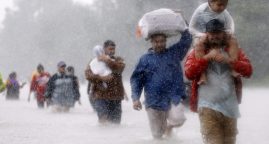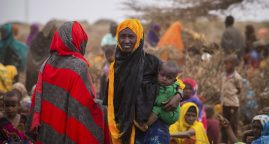Across the Middle East, Doctors Are Being Killed Like Never Before
Physicians, nurses and patients are under assault by the Syrian and Russian air campaign and U.S.-backed Saudi war in Yemen.
The first Russian airstrike missed the Sarmin field hospital in Idlib, Syria, by more than 20 yards — delivering a strong enough punch to blow out some windows but sparing the lives of the rattled patients and doctors inside.
Their luck would prove fleeting.
Ten minutes later, the Russians returned and fired on the road adjoining the hospital, killing a physiotherapist, a security guard, and 10 other patients and visitors. The trauma room was transformed into a scene of broken glass, rubble, and bloodied bodies. Mohamed Tennari, a Syrian radiologist who survived the Oct. 20, 2015, attack, told Foreign Policy that staff now see the hospital — which has been attacked 15 times since 2011 — as a “a ticking time bomb.”
“We don’t know when a bomb will explode and kill us all,” he said.
Tennari and his colleagues are far from the only doctors, nurses, and ambulance drivers worrying about theirsafety. Attacks against hospitals and clinics from Afghanistan to South Sudan and Yemen have grown distressingly common in recent years, killing hundreds, forcing the shuttering of numerous medical facilities, and adding to the misery of already war-torn nations.
Their plight has burst into public view in recent months following a series of gruesome attacks on facilities supported by the Nobel Peace Prize-winning French medical relief organization Médecins Sans Frontières (MSF). On Oct. 3, 2015, a U.S. military gunship mistakenly struck a hospital in Kunduz, Afghanistan, killing 42 patients, staff, and caretakers while injuring 43 more. The relief agency has also taken hits in Syria and Yemen, where a U.S.- and British-backed coalition led by Saudi Arabia has fired on two hospitals and one mobile clinic supported by MSF. Scores of other medical facilities have been destroyed by the Saudi-led coalition or opposition Houthi fighters. In South Sudan, MSF facilities were recently looted in the town of Pibor after fighting in the town forced the agency’s doctors and staff to flee to a U.N. compound for safety.
In a sign of the mounting concern over the targeting of hospitals, U.N. Secretary-General Ban Ki-moon scolded Russia and Syria for “severely disrupting” humanitarian operations and damaging hospitals and schools. He also took a veiled swipe at U.S. and Saudi air operations in Afghanistan and Yemen, denouncing “so-called ‘surgical strikes’” that hit medical facilities last year as “assaults on our common humanity.”
The attacks have grown so numerous and alarming that several U.N. Security Council members have begun discussions on a draft resolution condemning such attacks and highlighting the need for combatants to observe long-standing legal obligations to leave them in peace. “We felt that by highlighting the issue it might bring some pressure to bear” on the perpetrators, said New Zealand’s U.N. ambassador, Gerard van Bohemen, who is spearheading the effort. He said that international law governing conduct in armed conflict is clear. “There is a requirement not to attack health care facilities, and it’s not being complied with.”
Attacks on medical workers have always been a part of the reality in conflict zones. Governments at war have long bridled at the constraints imposed by the laws of armed conflict, which provide legal protections to medical workers tending to civilians as well as to wounded fighters on both sides of the conflict. Those protections include aiding injured enemy combatants who may one day return to the battlefield. Medical workers are On the ground, that has sometimes resulted in anger and violence. Israel, for example, has long faced harsh
On the ground, that has sometimes resulted in anger and violence. Israel, for example, has long faced harsh criticism from human rights advocates for targeting clinics and health workers in the course of military operations in Palestinian lands. But Israel has countered that Hamas and other terrorist groups have transported weapons in ambulances and staged rocket attacks from schools and medical facilities. The Shifa Hospital in Gaza City has been used as the de facto headquarters for Hamas’s leadership, according to a report in the Washington Post.
Laws designed to protect medical workers in time of war date back to 1864 with the adoption of the first Geneva Convention — or “Convention for the Amelioration of the Condition of the Wounded in Armies in the Field” — which obliges states to offer relief to the war-wounded. The convention was updated and replaced in 1906, 1929, and finally in 1949, following World War II. Its sanctity is not absolute. Armed groups are permitted to fire on a medical facility if they receive direct fire from within the premises. But the response must be targeted and proportional.
It is difficult to precisely quantify or compare whether medical workers are facing riskier conditions today than in previous conflicts, according to Jason Cone, the executive director of MSF’s U.S. branch. Medical workers have been targeted from Bosnia in the 1990s to Bahrain in 2011, where doctors tending to injured anti-government protesters were subject to arrest or violence in the early months of the so-called Arab Spring. The Khmer Rouge in Cambodia murdered doctors and other professionals or put them in labor camps in the 1970s. In the 1980s, Soviet aircraft frequently bombed hospitals in Afghanistan, including MSF-assisted clinics, during the Soviet Union’s struggle to defeat U.S.-backed mujahideen fighters, Cone said.
Article pubished on Foreign Policy website
Related Articles
Hurricane Harvey floods Texas
09/29/2017. Malteser International Americas and the U.S. Associations of the Order of Malta deliver help for the people affected by the disaster.
Malteser International | Syria’s War Children | No lost generation
06/20/2017. Syria’s War Children | No lost generation
Famine looms in four countries as aid system struggles to cope, experts warn
02/12/2017. Campaigners say tens of millions in urgent need in Yemen, South Sudan, Nigeria and Somalia are in hands of an overwhelmed, outdated humanitarian network.



